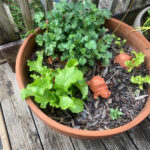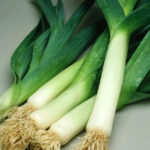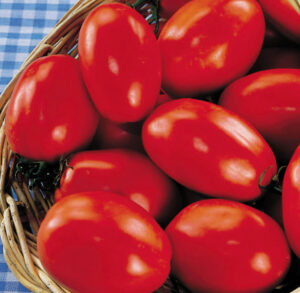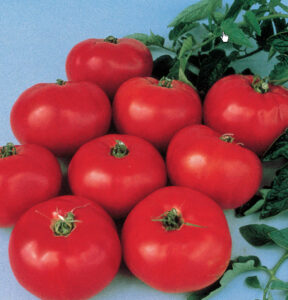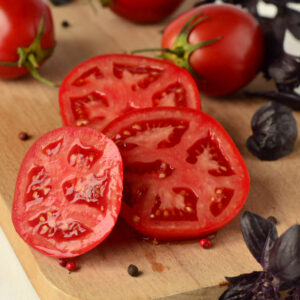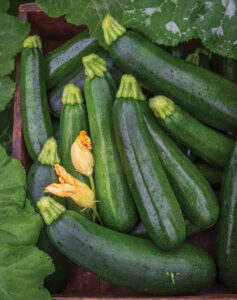| Veggies: |
| How to Prepare Eggshells for Tomato Plants Eggshells contains salmonella and other residues that can attracts pests like pesky slugs into your garden. Before using them as a fertilizer, it is important to wash them thoroughly and air them to dry.Alternatively, you can place the eggshells in a 300 degree heated oven for 5 to 10 minute. This will kill any bacteria on the surface as well as drying up any residues. Remove them from the oven and place them in a food processor to convert them into a powder.As a gardener, you may see this process as unnecessary but it is very important. Powdered eggshells are easily absorbed by the plants. If you don’t have a food processor, you can simply grind the shells using a pestle and a mortarHow to Add Eggshells to Tomato Plants There are different ways you can use to add eggshells to your tomato plants. They include:Using Eggshells when planting Eggshells contains a lot of calcium that can help to nourish the plants. To ensure your plants benefits from this nutrients, add some crushed eggshells into the planting holes before you plant the tomato. They will decompose and release calcium, potassium, magnesium, zinc and iron into the soil. As they do so, the plants will absorb the nutrient through their roots.Using eggshells powder when watering Crush the eggshells using a grinder or a pestle and mortar to obtain a powder. Mix the powder with water and apply it at the base of the plant. The plant will absorb the water together with calcium and other nutrients through the roots. FertilizerEggshells are made up of 34% calcium and also contain magnesium, potassium, phosphorus, and nitrogen. Coffee GroundsCoffee grounds are full of nutrients beneficial to plants such as calcium, potassium, nitrogen, and magnesium. For maximum effect, rinse your coffee grounds to help them achieve a neutral pH level of 6.5 so they do not increase the acidity of the soil around your vegetables. Coffee grounds are often used as a natural fertilizer and help to improve drainage. They can also be added to compost as they provide nitrogen. MilkMilk is also a good alternative to eggshells as a fertilizer in your garden. Milk is high in calcium and can help to strengthen your vegetables. In order to use milk as a fertilizer, create a mixture of half water and half milk. This can be sprayed on the soil above the plants’ roots. Banana PeelBanana peel makes a great natural fertilizer for your garden as it contains 42% potassium, a key component of fertilizer. Potassium is important as it helps strengthen plants cells and fights against disease. To use banana peel, place them in a sealable container and fill with water. Ensure the water covers the banana peels completely otherwise they will start to turn moldy. Let them sit in the water for a week and then use the water to spray over the soil around your vegetables. |
|
|
The American Flag Leek is a sweet member of the onion family. To use leeks, cut off their roots (the very tip of their white stems) and then dice, slice and/or mash them in any way you’d like. Leeks are cold tolerant. Fill Weight (grams): 1.55 Tolerance: Cold. Full sun. Germination: 10-15 days. Maturity: 150 days You can start American Flag Leek seeds indoors in a sunny location 8 weeks before the last frost. (Plants about 6″ tall will transplant best) or you can sow leek seeds directly in the garden every 2″ and cover with soil; thin to 4″ apart when 4″ tall. Note: As leeks mature, they should be earthed up and blanched like celery. Planting Depth: .5″ Seed Spacing: Sow American Flag Leek seeds roughly 4″ apart in rows. Leeks need a long growing season to reach full size. A leek can be left in the ground until a hard freeze or pulled when mature and stored in a cool area. |
|
Mezza Lunga Nantese Carrots grow to about 6″ long and have a very sweet taste. Full sun. Germination: 8-12 days. Maturity: 55-72 days Fill Weight (grams): 0.2 n full sun and well-drained soil, sow 3 Mezza Lunga Nantese Carrot seeds per inch in the row. Cover seeds firmly with soil. When plants are 2″ tall, thin to 2″ apart in the row. For fresh carrots all season, plant every 3 weeks until 75 days before the first fall frost. Planting Depth: .25″ Seed Spacing: Sow Mezza Lunga Nantese Carrot seeds roughly 2″ apart in rows, keeping rows approximately 15″ apart. Too much water can cause carrots to crack. They should be kept weeded (a clean mulch can reduce this job). Also, lightly place soil over exposed roots to prevent cracking. |
|
Flavor and aroma in every large, plump, delicious 4½- to 5-ounce plum tomato. Classic Italian variety is juicy yet meaty. Tomato arises freely on very vigorous plants that continue setting fruit all summer. Very easy to grow, San Marzano stands up to Fusarium wilt, nematodes, tobacco mosaic virus, and verticillium wilt. You will find it a trouble free pleasure in the garden. Start seeds indoors 5 to 6 weeks before the last frost date. Plant outdoors when danger of frost is past and night temperatures consistently remain above 55 degrees Fahrenheit. Set plants 6 inches apart. |
|
The most popular heirloom tomato in America, Brandywine earns its name with indescribably rich flavor seldom found in modern varieties. It’s tangy in the classic tomato way, but also rich and sweet, with a juicy succulent bite that really satisfies. Brandywine sets big fruit of purplish-red, deeply lobed and not at all “uniform”. The plants are indeterminate, for good yields over a long season. The fruit is surprisingly large—12 ounces or more—and no two will look exactly alike. Attention-getting, distinctive, and tried-and-true. Set plants 2 to 2½ feet apart. Tomato Fruit Set Indeterminate |
|
Sweet Million Hybrid Cherry Tomatoes. These vigorous plants bear masses of sweet “cherries”. Days to Maturity: 65 from transplant. Indeterminate Large clusters of smooth, bright, miniature fruit arise all summer. The bright red, 1- to 1 ½-inch globes are sweet and tender, arising plentifully on indeterminate plants resistant to fusarium wilt race 1, nematodes, tobacco mosaic virus, and leaf spot. Set plants 2 to 2½ feet apart. |
|
Better Bush Hybrid Tomato Seeds Old-fashioned-flavored tomato with the juiciness and distinctive “tang” you remember from vine-fresh tomatoes of the past. These big, luscious, 4-inch fruits grow very densely on indeterminate 4-foot plants, thanks to shorter internodes. This plant begins early in the season and just keeps going. Resistant to verticillium wilt and Fusarium wilt race 1. Set plants 2 to 2½ feet apart. |
|
Spine-free plants yield plentiful full-size 6-8” deep-green fruits. Germination: 8-10 days. Full sun. Planting Depth: 1″. After frost, sow directly outdoors in a sunny location. Sow 4-6 seeds around a 12″ diameter hill. After germination, thin to 3 seedlings per hill. Harvest squash regularly. Seed Spacing: Sow Black Beauty Squash seeds roughly 4′ apart in rows. For an elegant presentation, pick young fruits with flower attached, steam lightly, and serve the whole squash. |
|
Acorn Table Queen: Indoors: 2 to 3 weeks before setting out. Cover seeds with l/2 to 3/4 inch fine soil well firmed down. Size: A medium sized, acorn shaped, vining type. The flesh of this heirloom acorn is a sweet golden yellow that turns more orange in storage and the rind is dark green and ribbed. Fruits grow to 6″. GARDEN HINTS: Leave on vine until fully mature. Harvest before frost, leaving part of the stem attached to the fruit. Store for winter use at 45-55 F in a dry place. |
Growing Squash:Sow seeds directly in the garden in fertile, warm soil in full sun after danger of frost has passed. How to Grow:Squash plants have a shallow root system, mulches help retain soil moisture and maintain even soil temperatures. Tips:
|
Squash: Common Pests and ProblemsAlternaria Leaf Spot: Small, round reddish brown spots, usually with a yellow halo, form on the upper surface of the leaves. Severely infected leaves turn brown, curl upward, wither and die. Fruit are not usually infected but can suffer from sunscald due to leaf loss. This disease is worse in warm, wet or very humid weather. Burpee Recommends: Avoid getting water on the foliage. Remove infected plant parts and do not work around wet plants. Provide plenty of air circulation. Contact your Cooperative Extension Service for fungicide recommendations. Anthracnose: This is a fungus disease that attacks the fruit as it is ripening. Irregular brown spots develop on the leaves. Fruit infection is sunken black spots that may have white mycelia during wet weather. The spots enlarge and turn black; the fruit rots. Extended periods of heat and humidity facilitate anthracnose growth. The fungus overwinters in diseased plant debris. Burpee Recommends: Provide sufficient space between plants for good air circulation, avoid overhead watering which can spread the fungus spores, keep a clean garden, remove and discard all diseased plant material and rotate crops. Bacterial Wilt: Leaves turn brown, stems wilt and shrivel, the infected plants die. Burpee Recommends: Remove and destroy plants showing signs of the disease. Control cucumber beetles, which spread the disease. Contact your Cooperative Extension Service for fungicide recommendations. Black Rot: This starts while the fruit is in the garden but symptoms may not show up until fruit is stored. Bronze, brown or black patches appear on the fruit before or after harvest. Fruit will quickly collapse and rot. Burpee Recommends: Avoid getting water on the fruit. Keep fruit off the ground with a mulch like straw. Do not store wet fruit. Provide plenty of air circulation during storage. Contact your Cooperative Extension Service for fungicide recommendations. Mosaic Virus: Young leaves are distorted and mature leaves will have an intensive mottled appearance. Fruit can have yellow spots or bumps. The disease is quite serious and be transmitted by aphids or cucumber beetles. Burpee Recommends: Remove and destroy any infected plant. The virus can overwinter in weeds so keep the garden clean. Monitor and treat for aphids and cucumber beetles. Contact your Cooperative Extensions Service for recommendations in your area. Powdery Mildew: This fungus disease occurs on the top of the leaves in humid weather conditions. The leaves appear to have a whitish or greyish surface and may curl. Burpee Recommends: Avoid powdery mildew by providing good air circulation for the plants by good spacing and pruning. Contact your Cooperative Extension Service for fungicide recommendations. Common Pest and Cultural ProblemsAphids: Greenish, red, black or peach colored sucking insects can spread disease as they feed on the undersides of leaves. They leave a sticky residue on foliage that attracts ants. Burpee Recommends: Introduce or attract natural predators into your garden such as lady beetles and wasps who feed on aphids. You can also wash them off with a strong spray, or use an insecticidal soap. Blossom End Rot: Ends of the squash gets soft before they are ready to harvest. This can occur when there is not enough calcium in the soil or when root damage and water stress reduce the uptake and movement of calcium through a plant. Burpee Recommends: To avoid BER, properly site and prepare your garden bed before planting. Most crops need full sun and loose, well-drained organic soil. Test your soil to see if calcium is recommended. If it is, apply lime in the recommended quantity according to manufacturer’s instructions. Avoid planting too early in cool soils as this can inhibit early root development, making the plant more susceptible to BER. Avoid wide fluctuations in soil moisture by applying 2-3 inches of mulch. This will moderate the release of water to plant roots, and also keep the soil from drying out when it is directly exposed to the sun. Cucumber Beetles: Beetles may be spotted, striped or banded and can be very harmful. Beetles are usually ¼ to ½ inch in size. Beetles start feeding as soon as they hatch and can kill or slow the growth of the plants. Beetle larva can also bore through the roots of the plants. Beetles can also transmit diseases from plant to plant. Burpee Recommends: Knock off adults into a jar of soapy water and destroy them. Spade the soil to destroy dormant beetles before you plant. Use a row cover to prevent adults from feeding on young plants. Consult your Cooperative Extension Service for other insecticide recommendations. Squash Vine Borer: The brown headed larva will bore into stems, feed through the center of the stems, block the flow of water and the plants will collapse and die. The first sign of this pest is that the plant will wilt during the day and perk up at night. Check the base of the plant for holes and you will see what looks like sawdust. Burpee Recommends: Pull and destroy any plants killed by squash vine borers. Row covers will prevent the female from laying her eggs. In most areas there is only one generation each year so a second crop can be planted in early July. Although you can’t always save the plant, as soon as you see the wilting plant, cut a slit in the stem above the hole using a sharp knife. Kill the borer with the tip of the knife, or pull it out. Mound soil over the cut area and keep the soil moist. New roots may grow and the plant may live. Rotate crops. Consult your Cooperative Extension Service for insecticide recommendations. Spider mites: These tiny spider-like pests are about the size of a grain of pepper. They may be red, black, brown or yellow. They suck on the plant juices removing chlorophyll and injecting toxins which cause white dots on the foliage. There is often webbing visible on the plant. They cause the foliage to turn yellow and become dry and stippled. They multiply quickly and thrive in dry conditions. Burpee Recommends: Spider mites may be controlled with a forceful spray every other day. Try hot pepper wax or insecticidal soap. Check with your Cooperative Extension Service for miticide recommendations. FAQs Why do my plants have flowers but no fruit? Why is my spaghetti squash green and not yellow? If my squash are next to my pumpkins, will I get mixed (hybrid) fruit? How long will winter squash store? Can I eat summer squash raw? Why do my tiny fruit turn brown and fall off? What are good companion plants for my squash? |
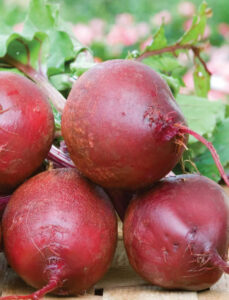 Beet, Detroit Supreme From Seed Outdoors Fall Start: Sep 20 – Oct 04 How to Sow and PlantSow beet seeds in well-worked, well-drained soil in full sun after danger of frost in spring. In frost free areas, sow in fall. Beets are sensitive to acidic soils and prefer a pH of 6.0 – 7.0. If your soil is more acidic, add Garden Lime as directed on the bag. Sow thinly in rows 12 inches apart and cover with ½ inches of fine soil. Firm lightly and keep evenly moist. How to Grow:Keep plants well watered during dry periods to promote uninterrupted growth. Plants need about 1 inch of rain per week during the growing season. Use a rain gauge to check to see if you need to add water. It’s best to water with a drip or trickle system that delivers water at low pressure at the soil level. If you water with overhead sprinklers, water early in the day so the foliage has time to dry off before evening, to minimize disease problems. Keep the soil moist but not saturated. Monitor for pests and diseases. Tips:Harvest roots at 1 inch for baby beets, up to 3 inches for mature beets. Beet roots can be pickled, grilled, baked or broiled. Common Disease Problems:
Alternaria Leaf Spot: Small, round reddish brown spots with white to gray centers for on the upper surface of the leaves. The lesions may encircle the stems and cause wilt. This disease is worse in warm, wet or very humid weather. Burpee Recommends: Avoid getting water on the foliage. Remove infected plant parts and do not work around wet plants. Provide plenty of air circulation. Contact your Cooperative Extension Service for fungicide recommendations. Curlytop: This is a virus disease that is characterized by yellowing, stunting and eventual death of plants. It is spread by leafhoppers. Burpee Recommends: Control the leafhoppers which spread the disease and remove and destroy infected plants. Downy Mildew: This fungus causes whitish gray patches on the undersides and eventually both sides of the leaves. Burpee Recommends: Rotate crops with plants in a different family. Avoid overhead watering. Provide adequate air circulation, do not overcrowd plants. Do not work around plants when they are wet. Powdery Mildew: This fungus disease occurs on the top of the leaves in humid weather conditions. The leaves appear to have a whitish or greyish surface and may curl. Burpee Recommends: Avoid powdery mildew by providing good air circulation for the plants by good spacing and pruning. Contact your Cooperative Extension Service for fungicide recommendations. Root Rots: A number of pathogens cause root rots of seedlings as well as mature roots. Burpee Recommends: Practice crop rotation and do not plant related crops in the same area for several years. Pull up and discard infected plants. Make sure your soil has excellent drainage. Contact your Cooperative Extension Service for recommendations. Common Pest and Cultural Problems Aphids: Greenish, red, black or peach colored sucking insects can spread disease as they feed on the undersides of leaves. They leave a sticky residue on foliage that attracts ants. Burpee Recommends: Introduce or attract natural predators into your garden such as lady beetles and wasps who feed on aphids. You can also wash them off with a strong spray, or use an insecticidal soap. Flea Beetles: These small hopping beetles feed on plant foliage. Burpee Recommends: Rotate crops with plants in a different plant family. Use floating row covers to prevent damage to young foliage. Leafhoppers: Leafhoppers cause injury to leaves and stunt growth. They also spread disease. Burpee Recommends: Remove plant debris. Use insecticidal soaps. Consult your Cooperative Extension Service for other insecticide recommendations. Leafminers: These insects bore just under the leaf surface causing irregular serpentine lines. The larvae are yellow cylindrical maggots and the adults are small black and yellow flies. They do not usually kill plants, but disfigure the foliage. Burpee Recommends: Remove affected foliage. Webworms: These worms skeletonize leaves and draw them into a web. Burpee Recommends: Contact your Cooperative Extension Service for insecticide recommendations. FAQs:Why are my beets not forming a root? Why are my beets woody and flavorless? |

